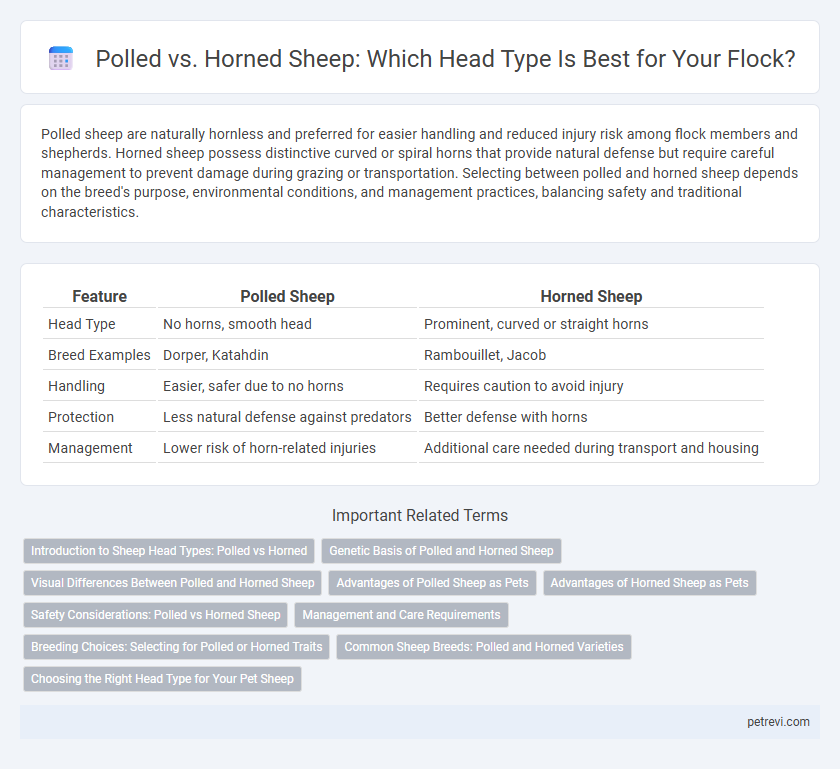Polled sheep are naturally hornless and preferred for easier handling and reduced injury risk among flock members and shepherds. Horned sheep possess distinctive curved or spiral horns that provide natural defense but require careful management to prevent damage during grazing or transportation. Selecting between polled and horned sheep depends on the breed's purpose, environmental conditions, and management practices, balancing safety and traditional characteristics.
Table of Comparison
| Feature | Polled Sheep | Horned Sheep |
|---|---|---|
| Head Type | No horns, smooth head | Prominent, curved or straight horns |
| Breed Examples | Dorper, Katahdin | Rambouillet, Jacob |
| Handling | Easier, safer due to no horns | Requires caution to avoid injury |
| Protection | Less natural defense against predators | Better defense with horns |
| Management | Lower risk of horn-related injuries | Additional care needed during transport and housing |
Introduction to Sheep Head Types: Polled vs Horned
Sheep head types are primarily categorized into polled and horned varieties, where polled sheep naturally lack horns, offering ease in handling and reduced injury risk among herd members. Horned sheep possess prominent, curved horns that serve as tools for defense and dominance but may require extra care to prevent entanglement or injury. Understanding these differences aids farmers in selecting breeds suited for specific climates, management practices, and farming goals.
Genetic Basis of Polled and Horned Sheep
The genetic basis of polled and horned sheep is primarily determined by the presence or absence of specific alleles at the RXFP2 gene locus, where the dominant allele typically results in hornlessness (polled) and the recessive allele leads to horn development. Polled sheep lack horns due to a mutation that suppresses horn growth, while horned sheep carry alleles that permit normal horn formation. Understanding these genetic variations is crucial for breeders aiming to select for desired head types and manage flock characteristics effectively.
Visual Differences Between Polled and Horned Sheep
Polled sheep have smooth, rounded heads without any horns, creating a cleaner and more streamlined appearance, while horned sheep display prominent, curved or spiral horns that vary in size and shape depending on the breed. The visual contrast between polled and horned sheep is particularly evident in breeds such as Dorset and Merino, where polled individuals lack the distinctive horn structures that characterize their horned counterparts. These differences in head type not only influence the sheep's silhouette but also affect handling and management practices on farms.
Advantages of Polled Sheep as Pets
Polled sheep, which naturally lack horns, offer significant advantages as pets due to their reduced risk of injury to handlers and other animals, making them safer for families and children. Their hornless heads simplify grooming and handling, minimizing the chance of entanglement or damage in confined spaces. Polled sheep also tend to be easier to manage in small-scale farming or backyard settings, enhancing their suitability as companion animals.
Advantages of Horned Sheep as Pets
Horned sheep possess natural defense mechanisms that enhance their safety as pets by deterring potential predators. Their horns also play a vital role in social hierarchy and communication within flocks, promoting healthier interactions. Furthermore, horned breeds often exhibit greater adaptability to harsh environments, making them resilient and low-maintenance companions.
Safety Considerations: Polled vs Horned Sheep
Polled sheep, lacking horns, significantly reduce risks of injury among flock members and handlers, enhancing overall farm safety. Horned sheep pose challenges due to their potential to cause accidental wounds during close interaction and require more careful handling techniques. Choosing polled breeds or selectively breeding for hornless traits supports safer livestock management and minimizes the need for specialized equipment.
Management and Care Requirements
Polled sheep, lacking horns, require less space and reduce injury risks within flocks, simplifying handling and transport. Horned sheep need careful management to prevent horn damage and entanglement, demanding regular inspection and potential trimming. Choosing polled breeds minimizes labor and veterinary costs associated with horn-related injuries and complications.
Breeding Choices: Selecting for Polled or Horned Traits
Breeders select polled or horned sheep based on management goals and environmental conditions, with polled sheep preferred for easier handling and reduced injury risk. Horned sheep are often favored for traditional breeding programs or traits linked to hardiness and natural defense. Genetic testing helps identify carriers of horned or polled alleles, enabling targeted breeding strategies to optimize herd characteristics.
Common Sheep Breeds: Polled and Horned Varieties
Common sheep breeds exhibit distinct head types, categorized as polled (hornless) and horned varieties, which influence their handling and suitability for different environments. Polled breeds like Suffolk and Polled Dorset are preferred for easier management and reduced injury risk, while horned breeds such as Jacob and Rambouillet offer natural protection and breed-specific genetic traits. Understanding the head type variations in sheep is crucial for breeding programs, flock health, and adaptation to farming conditions.
Choosing the Right Head Type for Your Pet Sheep
Choosing the right head type for your pet sheep depends on factors such as breed, management style, and safety considerations. Polled sheep, naturally without horns, are often preferred for ease of handling and reduced risk of injury to other animals and handlers. Horned sheep may require more space and careful management but are valued for breed authenticity and natural behaviors.
Polled vs Horned for Sheep Head Type Infographic

 petrevi.com
petrevi.com